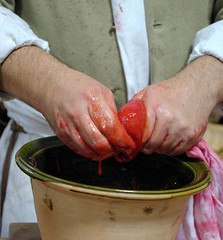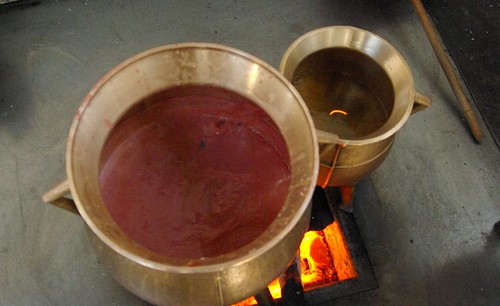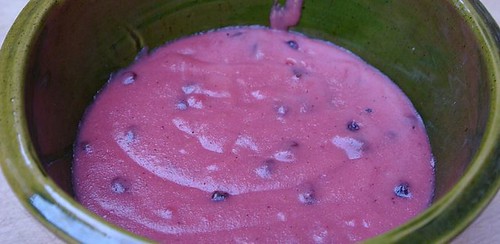Another post by Robert to keep things moving along! Enjoy and why not have a try at home?
November, and the winter nights are getting longer, it may be time to think about one of our favourite dishes, part of our menu on Sunday 27th of September. Yes it's fylettys en galentyne, a good dish for the chillier weather, and one of the history recipes that our cooks regularly make at home.
Well, it starts promisingly. 'Take fayre porke, the fore quarter, an take of the skyne; an put the porke on a fayre spete, an rost it half y-now'. This is how we usually do it, put pork on the spit in front of the fire, until roasted a bit more than half done; but on the 27th we put our pork fillets on a griddle over the charcoal stoves. To see what would happen, really...
Fyletes are defined in a note in the Forme of Cury as 'that buth [be] take oute of the pestels [legs]', leg of pork. And another note says 'The loyne of the pork is fro the hippe boon to the hede.', which is similar to the modern term; the modern cutting diagram shows the loin ending about half way to the head. Although the fillet of pork is now a tender cut of the loin; tender because these muscles are 'not used for locomotion'.
Our recipe calls for the front quarter, so we tend not to be too fussy, we usually choose a joint we can get on the spit. Then half roast it, a Forme of Cury version says 'till the blode be tryed out'. And this time we didn't go to the trouble of using the spit. As this dish is so popular with us, we wanted to see how it would turn out making slightly less of a performance of it, hopefully to show our visitors that it could be made at home.
Our recipe continues fairly straightforwardly, cut up the pork, put in a pot (to be fair, it's 'fayre pecys' and a 'fayre potte'). Fry medium cut onions in a pan, and put them with the pork with beef or mutton broth. Add ground pepper, canel, cloves and mace, and boil well. We then thicken with bread, add vinegar and simmer for a bit longer. The recipe says 'tak farye brede, an vynegre, an stepe the brede with the same brothe, an strayne it on blode, with ale, or ellys sawnderys, and salt, an lat hym boyle y-now, an serue it forth'.
I've bothered with this bit because even when a historic recipe is going well, something a bit strange crops up... Blood, ale or sandlewood?
There is a simpler version from the Forme of Cury; 'Drawe a lyour (thickening) of brede and blode and broth and vyneger, and do therinne'. Then boil and add pepper and salt.
Unsurprisingly, the Forme of Cury has also a more complicated version; it goes on a bit, highlights include using bread crusts ground in a mortar, boiling the pork to make it more tender, and adding pepper, sandlewood, parsley, hyssop, red or white wine, grease and raisins.
So there is some scope for making it at home; both Robin and Marc have done this, and I have persuaded them to share their tips...
Marc likes to fry the pork steaks (about half an inch thick) until they start to brown, then fry the onions (three good sized ones for six people) in the pork fat, and put the whole lot in a casserole dish. If you don't have a stock, make one up from stock cubes, beef or lamb, and vegetable, made a bit stronger than usual, de-glaze the pan with it, and add to the dish. Add the spices, ground pepper, mace, two or three cloves and, Marc being a purist, ground cassia. He buys his cassia from an asian supermarket, where it is called 'dalchini'. He uses, as we all do, Robin's method of assessing the spice mix by smelling the mixture, and if one scent predominates, then adjust to make it more harmonious.
Ten or fifteen minutes before ready, take a ladle full of stock and soak bread in it, add vinegar and return to the pot to thicken.
Robin's version is similar, except he likes to grill (broil) the pork, only uses salt and pepper to season, and reduces the mixture by simmering in a saucepan. It really is very easy!
And I find it a useful way to make something nice from left over roast pork.
How about a version we haven't tried yet? This one is from 1500, and with the white wine and ginger should be interesting. I'll quote it in full, in case anybody would like a go...
To make fyletts in galentyne take the beste of rybbes of porke & flee of the skynne & rost the fleshe tyll it be almost ynough than take it of & chop it in peces & put it in a potte with onyons butter or fayre grece and hole clowes maces quibybes and do it togyder with a cruste and trye it through a streynor & white wyne and do therto pouder of peper and put it in the potte and when it boyeth lette it not be chargeaunt & season it up with pouder of gynger & salt & serue it.
So; good luck!


Thanks Robert for that, I have to say that the recipe is genuinely idiot proof.....we really have never had a failure with this dish, yes some are better than others, but I think it would be fair to say that this is one recipe that we rarely have any left-overs at the end of a meal!
The keen eyed amongst you, well those that look at the stuff on the right hand side of the page at least, will have noticed that we'll be in action again this weekend; the last event before the big Christmas blow out!
Lots of roasting things planned for this last weekend along with a few other treats to keep Robert in writing for some time to come....perhaps we'll even persuade Marc H to write something too!
TTFN




